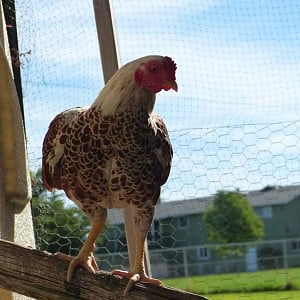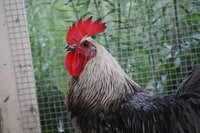This breed is different from any I've ever had. They do have limitations if you are counting on them for eggs or breeding for years. They give it their best their first year and from then on, they march to a different drummer than other breeds. If you keep breeding them so that you always have first year birds, there's no problem.
They seem to withstand the cold and heat pretty well. They aren't disease proof but they aren't sickly birds either. They have the most wonderful, friendly way about them, with a different sound than most chickens. They quietly vocalize, talking to you if you bother to talk to them. They are always at the front of the door in the morning or walking towards you, greeting you cheerfully when you enter the coop. They don't seem to like being picked up but they do like attention. They are an intelligent breed.
They can be a bit pugnacious to other birds, especially bantams, that are more docile than they are, but they aren't mean. In other words, they don't go out of their way to chase another bird to be hostile or bossy, but they can keep a shy bird away from the feeder or out of the coop for a while. It can be irritating at times but it's part of what makes the breed. They enjoy being outside and foraging, although with their short legs they don't stray too far from the coop.
Considering the pullets can be decent layers their first year and the cockerels will have a meaty breast within 6 months, they are ideal for one person or a small family. They don't take up a lot of space, they aren't unruly, mean, or make a lot of noise. They can chow down pretty well the first couple of months but after that, they level out on their eating. All in all, I think this is a really great breed of bantam and one of my very favorite regardless of size.
They seem to withstand the cold and heat pretty well. They aren't disease proof but they aren't sickly birds either. They have the most wonderful, friendly way about them, with a different sound than most chickens. They quietly vocalize, talking to you if you bother to talk to them. They are always at the front of the door in the morning or walking towards you, greeting you cheerfully when you enter the coop. They don't seem to like being picked up but they do like attention. They are an intelligent breed.
They can be a bit pugnacious to other birds, especially bantams, that are more docile than they are, but they aren't mean. In other words, they don't go out of their way to chase another bird to be hostile or bossy, but they can keep a shy bird away from the feeder or out of the coop for a while. It can be irritating at times but it's part of what makes the breed. They enjoy being outside and foraging, although with their short legs they don't stray too far from the coop.
Considering the pullets can be decent layers their first year and the cockerels will have a meaty breast within 6 months, they are ideal for one person or a small family. They don't take up a lot of space, they aren't unruly, mean, or make a lot of noise. They can chow down pretty well the first couple of months but after that, they level out on their eating. All in all, I think this is a really great breed of bantam and one of my very favorite regardless of size.


